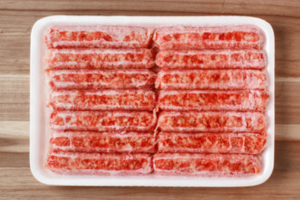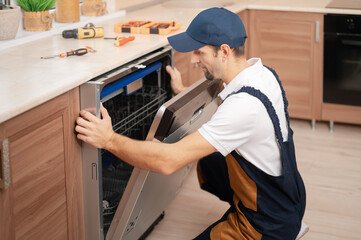
Freezer Burn
There are things in this world we take for granted and don’t think twice about. We live in an extremely privileged time and place where we all get clean water, a full kitchen of appliances, and most importantly, a preserve that makes our food last longer and won’t perish. Our refrigerators are probably the single most important appliance in the kitchen, not only does it do what it’s supposed to, but it saves us a lot of money.
Can you imagine going to the grocery store and buying a couple hundred dollars worth of food? If you didn’t have a fridge, the way we eat, shop and what we cook, when we cook, would be altered significantly. The fridge gives us dependability and consistency. They’re also expensive, and you need to take care of them! In this blog, we will get into the nitty-gritty, not just about the refrigerator, but the freezer.
Let’s be very clear, countless things can go wrong with your refrigerator, but there is one thing that can go wrong with your freezer that we sometimes ignore. I believe people ignore this problem often, and I am referring to freezer burn, something we have all experienced.
So before we delve into a bunch of technical facts, and the journey we’re about to go on, it’s probably good to identify what freezer burn is. Freezer burn is when your food is exposed to cold, dry air, and it sucks the moisture from the outer layers, causing it to lose moisture. It dries out your food and changes the texture and the taste. While your food is still preserved, it loses its appeal, and this is caused potentially by human error setting up your freezer, or an appliance fault.
Considering this is an appliance repair blog, it’s safe to say that we will be focusing on the technical aspects of why your freezer may be ruining your groceries, and how appliance repair is likely the route to go to resolving these issues.
Freezer Faults
To be clear, freezer burn doesn’t just happen, it can occur even when your appliance isn’t having any issues due to the unit. Maybe your power went out during the night and you opened the freezer door, didn’t realize it, and the temperature was affected. Freak accidents happen and they go unnoticed because we don’t have the luxury of being fully aware of our surroundings all the time. However, the truth is that there is usually a greater issue at play. You may be experiencing freezer burn due to human error, maybe you set the temperature to something that isn’t adequate for reservation?
You can set your freezer to a setting that doesn’t freeze your food properly, a little too hot, or a little too cold, you need to have it just right.
Freezer Temperature
Your freezer temperature should be put at 0 °F or -17.8 °C. This is the ideal temperature and there is no conversation about why it should be anything but this. Don’t adjust your freezer temperature, if you need to adjust it, there is something wrong. Seek professional assistance from your local appliance repair company.
Common Faults Causing Freezer Burn
- Improper Temperature Settings: If the freezer temperature is too high, it can lead to inadequate preservation and increased moisture loss from food, resulting in freezer burn.
- Faulty Door Seals: Damaged or worn-out door seals can allow warm air to enter the freezer, causing fluctuations in temperature and accelerating freezer burn.
- Inadequate Air Circulation: Poor airflow within the freezer can create pockets of warmer air, promoting uneven freezing and contributing to freezer burn.
- Overloading the Freezer: Overcrowding the freezer inhibits airflow and prevents proper circulation, leading to uneven cooling and increased risk of freezer burn.
- Frost Buildup: Excessive frost accumulation on freezer walls and coils restricts airflow and insulation, making it harder for the freezer to maintain consistent temperatures and increasing the likelihood of freezer burn.
- Defective Thermostat: A malfunctioning thermostat may inaccurately regulate the freezer temperature, causing fluctuations that can compromise food quality and lead to freezer burn.
- Insufficient Insulation: Poor insulation in the freezer walls or door can result in temperature fluctuations and condensation buildup, accelerating freezer burn on exposed food items.
- Dirty Condenser Coils: Dust and debris accumulation on condenser coils restrict airflow and impair cooling efficiency, leading to inadequate freezing and potential freezer burn.
- Inadequate Food Packaging: Improperly sealed or packaged food items are more susceptible to freezer burn as they are exposed to air and moisture, accelerating dehydration and deterioration.
- Extended Storage Periods: Foods stored in the freezer for extended periods are more prone to freezer burn due to prolonged exposure to low temperatures and air circulation.
Whether your freezer is in disarray due to any of these ten reasons, you are not likely capable of resolving these faults on your own. There are guides online that can take you through DIY, but let it be known that a fix by anyone other than a professional will likely cause further errors. Money spent now by a professional will be less money spent later.
It is known that appliance maintenance and proper care throughout its lifespan will help preserve it like your freezer is supposed to preserve your food.
At ARS Appliance Repair Service we charge a great price for a service call visit. It’s only 120+ tax for one of our certified and experienced technicians to come by your home, diagnose your appliance, and either fix it on the spot or return with the necessary parts to resolve what is causing your appliance’s fault. If your technician needs to come for a second visit, you will have your service call fee deducted on the second visit, and will only then be charged for the part needed to fix your appliance.
Why Appliance Repair Is Key.
We all can learn and resolve any issue, but someone trained in the profession is likely the route you’ll need to go. Ultimately, appliances can be costly, especially when you need to put some love and money into them, this is important because if you want longevity, a good appliance repairman is the key. Let’s touch back on some of these appliance faults and graze over what a technician might do to fix the fault, but the process at hand.
Technical Faults and Solutions in Freezers
Improper Temperature Settings
- Solution: Adjust the freezer temperature to the manufacturer’s recommended level (typically around 0°F or -18°C).
- Repair Procedure:
- The appliance Repair Tech would assess the current temperature settings using a thermometer.
- Adjust the temperature control knob or settings by the manufacturer’s guidelines.
- Fixable on First Visit: Yes, typically adjusted during the initial diagnostic and repair visit.
Faulty Door Seals
- Solution: Replace damaged or worn-out door seals to ensure a proper seal and prevent warm air infiltration.
- Repair Procedure:
- Inspection of door seals for signs of wear, tears, or damage.
- Removal and replacement of faulty door seals with new, properly fitting seals.
- Fixable on First Visit: Yes, if replacement seals are readily available and the repair can be completed during the initial visit.
Inadequate Air Circulation
- Solution: Rearrange freezer contents to allow for better airflow and circulation.
- Repair Procedure:
- The appliance Repair Tech would assess the freezer’s interior layout and organization.
- Rearrange items to ensure no obstructions blocking airflow vents or preventing proper circulation.
- Fixable on First Visit: Yes, typically addressed during the initial diagnostic and repair visit through reorganization.
Overloading the Freezer
- Solution: Remove excess items to alleviate overcrowding and restore proper airflow.
- Repair Procedure:
- Assessment of the freezer’s current contents and storage capacity.
- Removal of unnecessary items to reduce overcrowding and improve airflow.
- Fixable on First Visit: Yes, usually resolved during the initial visit through organization and removal of excess items.
Frost Buildup
- Solution: Defrost the freezer to remove excessive frost buildup and restore proper cooling.
- Repair Procedure:
- Turn off the freezer and allow it to thaw completely.
- Clean the interior to remove any remaining frost or ice buildup.
- Fixable on First Visit: Yes, if the frost buildup is not excessive and can be resolved through defrosting during the initial visit.
Defective Thermostat
- Solution: Replace the malfunctioning thermostat to ensure accurate temperature regulation.
- Repair Procedure:
- Testing of the thermostat’s functionality using specialized diagnostic tools.
- Removal and replace the faulty thermostat with a new one compatible with the freezer model.
- Fixable on First Visit: No, typically requires a second visit after diagnosis to procure and install the replacement thermostat.
Insufficient Insulation
- Solution: Repair or reinforce insulation in the freezer walls or door to improve temperature stability.
- Repair Procedure:
- Inspection of the freezer’s insulation for damage or degradation.
- Repair or replacement of damaged insulation materials to enhance thermal efficiency.
- Fixable on First Visit: Yes, if the repair does not require extensive replacement of insulation materials and can be completed during the initial visit.
Dirty Condenser Coils
- Solution: Clean the condenser coils to remove dust and debris and restore proper airflow.
- Repair Procedure:
- Accessing the condenser coils located at the back or bottom of the freezer.
- Thorough cleaning of the coils using a vacuum cleaner or specialized coil brush to remove accumulated dirt and debris.
- Fixable on First Visit: Yes, typically addressed during the initial diagnostic and repair visit through cleaning.
Inadequate Food Packaging
- Solution: Repackage food items in airtight, freezer-safe containers or vacuum-sealed bags to prevent moisture loss and freezer burn.
- Repair Procedure:
- Assessment of food packaging to identify items at risk of freezer burn.
- Repackaging vulnerable items in suitable containers or bags to minimize exposure to air and moisture.
- Fixable on First Visit: Yes, usually resolved during the initial visit through proper repackaging and organization.
Extended Storage Periods
- Solution: Rotate and consume stored items within recommended timeframes to minimize the risk of freezer burn.
- Repair Procedure:
- Review of stored food items to identify those approaching or exceeding expiration dates.
- Recommendation to consume or discard items nearing expiration to prevent freezer burn.
- Fixable on First Visit: Yes, typically addressed during the initial visit through recommendations for proper food rotation and storage practices.
Conclusion
Let’s make something clear, while freezer burn is normal, it doesn’t have to be. You don’t need to open your freezer and see your food ruined, that’s a fact. Your money is well earned, should be well spent, and well preserved. Let’s not throw money down the drain, and contribute to food waste, when we can enjoy the fruits of labor and have a fully operational freezer. If you can’t resolve your freezer temperature yourself, you have a problem. It is time to seek out appliance repair.
At ARS Appliances Repair Service, you can contact us via our call center and talk to a knowledgeable dispatcher who will help start your journey to end the burn. They can talk you through the next steps, and they’ll send out the next technician that can be sent your way and the next availability.

ARS Appliance Repair Service has been trusted across Toronto, Ottawa, and Southern Ontario for over a decade. Our licensed, manufacturer-authorized technicians specialize in repairing all major household and commercial appliances with genuine parts and warranty-backed service. From refrigerators and washers to ovens, dishwashers, and more, we restore appliances quickly, professionally, and correctly the first time, earning the confidence of homeowners and businesses throughout the region.





